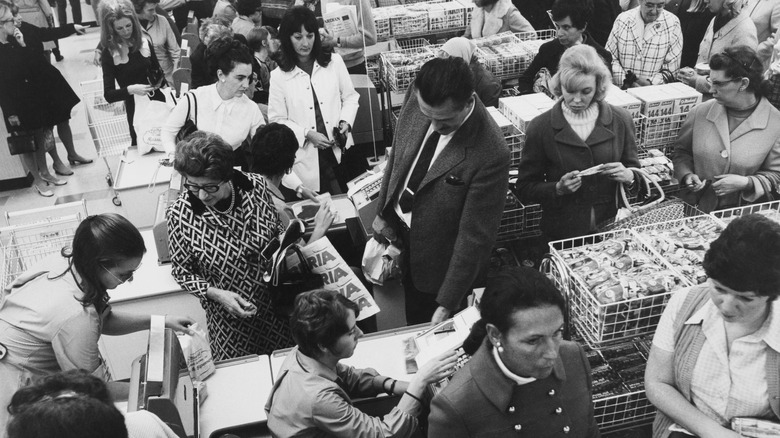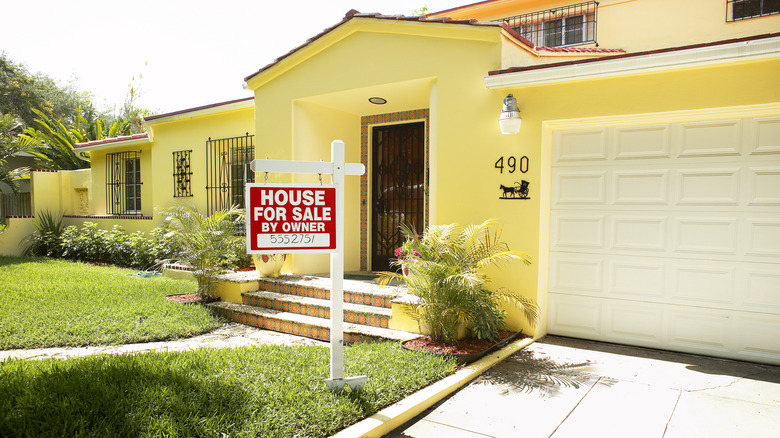The Surprising Price You'd Pay For Gas, Groceries, And A New House In 1975
These days, with pennies facing possible extinction and people regularly spending $5, or more, on their morning coffee, it's hard to imagine a time when a few coins would cover the cost of a loaf of bread or a gallon of milk. Even harder to believe is that 50 years ago, you could buy an entire house for less than what a single year of tuition at a private college currently costs. Yet, back in 1975, that was very much the reality, with prices surprisingly low compared to where they are now. That doesn't mean, however, that things felt less expensive back then. While inflation has caused prices to multiply from where they were decades ago — a dozen eggs, for example, used to cost less than a dollar five decades ago — the prices for many essentials, when adjusted for inflation, were actually higher than they are today.
In 1975, many of the same inflationary pressures the U.S. is facing today were also being felt. So, although the prices of essential items may seem dirt cheap when compared to 2025, it doesn't mean it felt affordable at the time. For instance, regular gas currently costs just over $3 per gallon, which is more than five times the average price in 1975 of 57 cents per gallon, according to the U.S. Department of Energy. However, due to an oil embargo that began in 1973, which caused prices to spike, gas was considered very expensive. Adjusted for inflation, the 1975 price was equivalent to about $3.50 in today's dollars, per the U.S. Bureau of Labor Statistics (BLS) CPI inflation Calculator.
The price of many groceries were more expensive than today, when adjusted for inflation
Grocery prices in 1975 were also seemingly low by today's standards — though high inflation at the time had pushed prices substantially higher, making items expensive for the time. In fact, the period from 1965 to 1982 was dubbed the "Great Inflation" as the inflation rate soared from 1% in 1964 to more than 14% in 1980 before starting to settle back down. To purchase a loaf of white bread would have cost 36 cents per pound in 1975, according to the BLS. In today's dollars, that translates to about $2.20, which is well above the current average price of $1.87 per pound, as reported by the Federal Reserve Bank of St. Louis (FRED). Milk, meanwhile, would have cost about 79 cents for a half gallon, per the BLS, which comes to $4.85 when adjusted for inflation. This is also higher than the current price of $4.13 per gallon, per FRED.
Eggs have seen a similar trajectory today as they did 50 years ago. Earlier this year, egg prices skyrocketed to $6.23 per dozen, per FRED, due to factors such as inflation and an egg shortage. Similar issues also occurred in 1975, which caused the average price of eggs to jump to 77 cents per dozen. While that sounds low in today's dollars, it is the equivalent of $4.80 — which is substantially more than where egg prices currently stand, at $3.58 per dozen, as of August 2025, per FRED.
Home prices are 10 times higher today than in 1975
Housing prices in 1975 may cause the greatest sticker shock when compared with today's prices. The average U.S. home price 50 years ago was $42,000, according to U.S. Census data – about ten times lower than Q2 2025's average price of $512,000, according to FRED. To put this in perspective, on an inflation-adjusted basis, the average price back then was closer to $250,000, per the CPI Calculator. At the time, that was considered expensive, as a construction slowdown had caused prices to rise, putting home ownership out of reach for many — much like today.
While homes were considered pricey in 1975, even after adjusting for inflation, today's prices are still about twice as high as they were back then — leaving many to wonder if younger generations will ever be able to afford a home. In recent years, U.S. home prices have surged due to a combination of factors, including strong demand, a lack of supply, and high interest rates over the last three years. The latter has kept many homeowners who had previously locked in lower mortgage rates, from selling their homes and giving up their low rates. The bottom line: although prices in 1975 may feel like a bargain by today's standards, it's not that simple. Affordability was still challenging, much like today, and in the case of certain essentials, such as gas and groceries, the sticker shock was often even more painful than it is today.


